Punk photographer Jim Saah shares the stories behind his favorite shots of Black Flag, Talking Heads, more
"In My Eyes: Photographs 1982-1997" showcases 332 pages of images from punk rock's heyday.
It all started with The Rocky Horror Picture Show. Had it not been for Dr. Frank-N-Furter, Magenta, and Riff Raff, Jim Saah may never have discovered punk rock, and his many indelible images — including the cover photo of the 1990 Fugazi album, Repeater — would never have existed.
“I ended up going to the midnight show of The Rocky Horror Picture Show down in Georgetown in 1982, and before the movie played they had a DJ, and there were a bunch of weirdos dancing to punk-rock music,” the Washington, D.C.–based photographer recalls. “He would play the Buzzcocks and the Stranglers and probably some New York stuff like the Ramones, and I was blown away almost immediately upon hearing this music.”
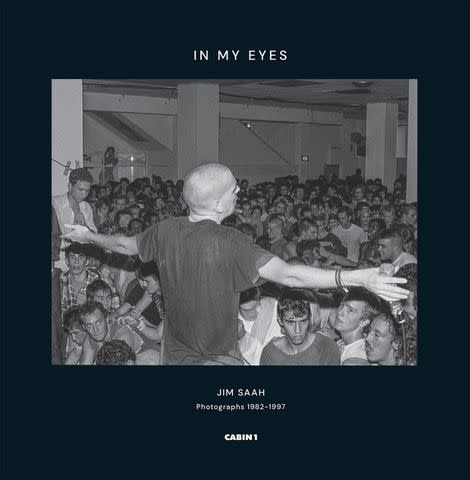
Jim Saah
Jim Saah's 'In My Eyes'Saah needed to know more. “I was like, ‘What is this music? I have to check it out.’ So I go to my local record store and ask them about it and they're like, ‘Yeah, those bands are good, but there are local punk-rock bands too.’ And I was like, ‘Oh, people make this music locally?’ So I went to my first show, which was Minor Threat and Government Issue at Maryland University, and I was hooked."
He did not take any pictures at that concert featuring the two legendary harDCore bands (“It was my first show and I didn't really know if photographs were allowed”), but in the 40 years since he has rarely been without his trusty camera. Now, Saah is releasing a second edition of In My Eyes: Photographs 1982-1997, his celebrated book capturing moments from punk’s heyday. The 332-page tome (available from Cabin 1) contains images of everyone from the obscure D.C. outfits Double-O and Madhouse to legendary punk and rock acts like the Damned, the Ramones, Foo Fighters, Pavement, Pixies, Sonic Youth, Lou Reed, and Iggy Pop.
EW sat down with Saah to get the stories behind his favorite shots of Black Flag, Dead Kennedys, Talking Heads, the Replacements, and Fugazi.
Black Flag (9:30 Club, Feb. 3, 1983)
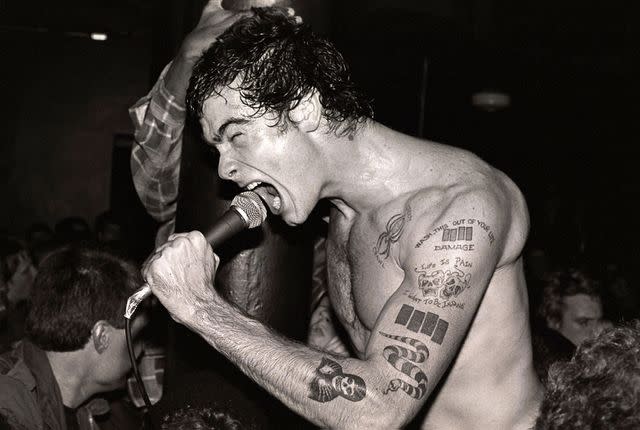
Jim Saah
Henry Rollins of Black Flag live in 1983, featured in Jim Saah's book 'In My Eyes'Henry Rollins (a.k.a. Henry Garfield) was singing for D.C. hardcore outfit S.O.A. when he joined the well-established punk outfit from Hermosa Beach, Calif., as their vocalist, taking over for Dez Cadena, who wanted to move over to second guitar. Because D.C. shows represented a homecoming for Rollins, Black Flag concerts in the nation’s capital were always raucous affairs, like this 1983 show Saah captured.
I was 17 years old and had been shooting shows for almost a year at this point, so I kind of got used to the activity. I would pick my spot, and I could anticipate things and protect my gear, but people went crazy, and it was nonstop action. People would jump over my head, and I'd pop up and take pictures. This one of Rollins is probably one of my most recognizable photos. I meet people and they don't know me or my name, but they'll see it and be like, “Oh, you took that photo!”
Rollins is just great to photograph because he's so intense. It is a fairly unique picture, even though it's not a very unique pose of his, because he would sing like that a lot. I have other pictures from that show of him with the mic in his mouth, and he's just screaming, and you see the veins in his neck. At that point I didn't know him and was intimidated by him, because he's scary.
Dead Kennedys (Lansburgh's, June 5, 1983)
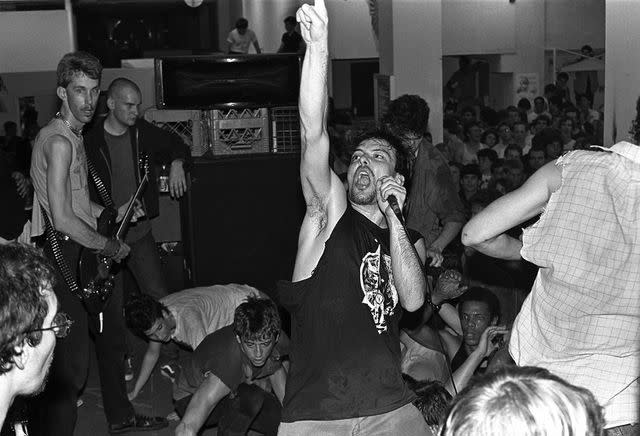
Jim Saah
Dead Kennedys in 1983Known for shocking song titles like “Holiday in Cambodia,” “Kill the Poor,” “Too Drunk to F---,” and “Nazi Punks F--- Off!,” San Francisco’s Dead Kennedys mixed politics and satire with lightning-fast guitar licks and the charismatic presence of singer Jello Biafra — who would later go toe-to-toe with Tipper Gore of the Parents Music Resource Center on The Oprah Winfrey Show.
This show was at an old department store from the '50s and '60s called Lansburgh's. My mother shopped there. It's kind of like what a Target would be now, and it closed. So it was just this huge space that they rented out. Minor Threat’s last show was there, and this Dead Kennedys show was noteworthy because it almost got shut down by the fire marshal, who showed up and got on stage.
It's funny because everyone thinks punk rockers are there to riot or something, but Ian MacKaye [of Minor Threat and later Fugazi, who can be seen on stage above with his arm on the speaker] came out and said, “Everyone, we're going to figure this out. Just sit down.” And everyone sat down. Jello Biafra and Ian went backstage and talked to the fire marshal, and I don't know what they said, but they came out and the show continued and everyone was well behaved.
They were a great band to photograph. I love hardcore, and the Dead Kennedys were hardcore, but they were so melodic with those East Bay riffs that were just so catchy. Jello was very political, and they actually taught me a lot and sent me to the library, getting out books and learning. I loved all the political bands.
Talking Heads (Merriweather Post Pavilion, Aug. 24, 1983)
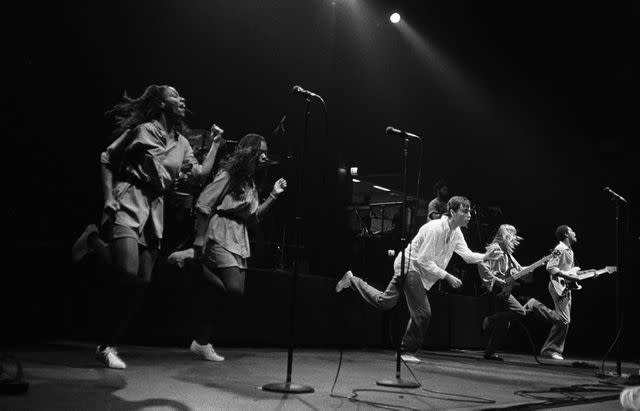
Jim Saah
Talking Heads live in 1983Jonathan Demme’s landmark concert film Stop Making Sense showed Talking Heads at the top of their game, and Saah had a front-row seat — well, standing general admission, actually — to that creative genius when he caught the tour during which that movie was made. But because the concert he attended was at a much bigger venue than Saah was used to, he had to use some stealth tactics to get this shot of David Byrne and Co.
This was the Stop Making Sense tour, and I was already hooked on photographing bands. My friends used to say, “Oh, why don't you just leave your camera at home and enjoy the show?” But I felt like I paid better attention at the shows if I photographed them. I just feel like I listen closer to the music and I know when a good shot is going to happen.
I was used to shooting punk shows where a photo pass didn't exist, but it did for big shows like this, at Merriweather Post, and I didn’t have one. So I snuck in a little Olympus clamshell pocket camera and got a picture of David Byrne on stage where he comes out and just does a song by himself, and then they roll out everyone else.
This picture of the whole band with one foot up, where they all kind of jump at the same time during “Life During Wartime” — I was probably right up by the side of the stage and no one stopped me. I don't remember getting in trouble or having anyone want to take my camera or take my film or anything. I guess they figured it was a little unprofessional camera and they weren't going to care about it, but I was so glad I snuck it in, and I'm so glad I saw that tour. It was amazing.
The Replacements, (Friendship Station, Sept. 23, 1983)
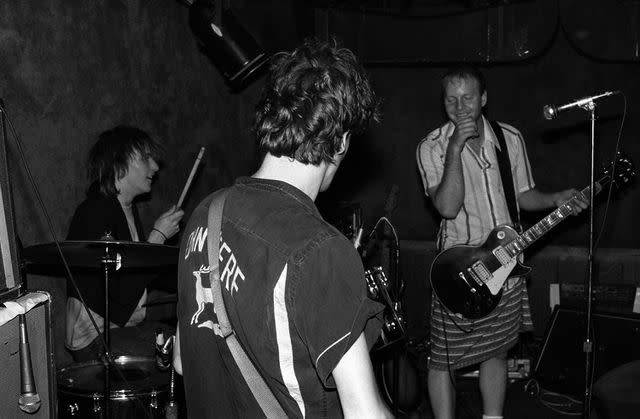
Jim Saah
The Replacements live in 1983The original lineup of the Replacements — featuring Bob Stinson on guitar, his brother Tommy on bass, Chris Mars on drums, and Paul Westerberg on vocals and guitar — comprised one of the most infamous live bands in history. The notorious Minneapolis foursome could perform the best or worst concert you ever saw, depending on the night and how much alcohol they had consumed. Saah happened to snap the band very much in their element, including them doing a very in-character instrument swap.
I was already aware of that mythology around them. We get there and they're all at the bar stringing their guitars and getting drunk and stuff. And we were too young and shy to go up to them and say anything. We were just watching them. So then they take the stage, already well lubricated, and they hardly did one of their own songs. It was all 1970s AOR [album-oriented rock] covers. In 1983, it was already a cliche to yell out “Free Bird” at a show, but someone did it and they went into it — I guess to call their bluff. So they only did covers, and they didn't finish any of them because every song would fall apart, and then they'd say, “Screw it!” and then go into another one.
And then as they got drunker and drunker, they started switching instruments, as they had been known to do. So Tommy went to the drums [seen above], and Chris took his bass, and it just fell apart. It was super sloppy. And then some of the band members left the stage, and my friend that I went to the show with started playing the drums. No one knows who he is! The owner comes out and sees half the band off the stage and some randos on the stage playing their instruments and freaks out and makes everyone get off the stage and the show is over.
I was of two minds. My friend John thought it was fantastic. But they sucked in that they didn't do any of their own songs, and they didn't finish any of the covers they did, and they left the stage. And so, the next time they came around at the old 9:30 Club. I was hesitant to go and thought, "I don't want to pay money to see another drunken catastrophe train wreck like that." But I went, and they were great. You really had to see them every time and just take what you get.
Fugazi (St. Augustine Church, Jan. 27, 1990)
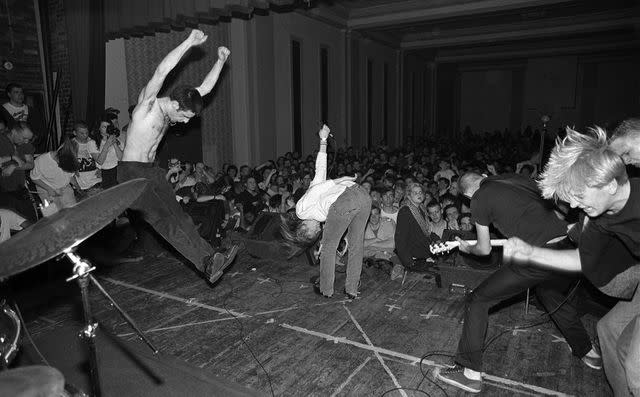
Jim Saah
Fugazi and Amy Pickering live in 1990Featuring former members of Minor Threat (Ian MacKaye) and Rites of Spring (Brendan Canty, Guy Picciotto) as well as the driving bass lines of Joe Lally, Fugazi burst onto the D.C. music scene in 1987, blending the power of punk, the groove of the local go-go scene, and the call-and-response of hip-hop. The band not only reinvigorated indie music in D.C. and well beyond, but also inspired Saah to pick his camera back up and begin shooting again, no more so than with this group.
Minor Threat broke up in 1983, and then the scene kind of got a little wonky. A lot of jocks and douchey people started coming, and I started not going to shows as much. And then Fugazi comes along and everyone's like, “You’ve got to check out Fugazi!” So I went to see them and I was totally blown away.
Fugazi is the band I’ve photographed the most. Ian told me, “I remember being really struck by your pictures of Fugazi when I first saw them. I had seen many other photos of us, and they were perfectly good representations, but your work often would look like the way I felt on stage.” I think I got a little teary when he said it. That meant a whole lot to me. They're a special band, and Ian was very helpful in curating this book. I started with probably a thousand or more frames of them, and then I narrowed that down to a few hundred, and then Ian helped me narrow it down to the 40-some-odd pictures that made it into the book.
As for this picture, they had a song called “Suggestion,” about how women can be objectified, and Ian and Guy sing it on the record, but whenever they did it live in D.C., they figured it was more appropriate to have a woman sing it since it's from a woman's point of view. Amy Pickering worked at Dischord Records and was in bands herself like Fire Party, and so they would have her come out and sing it.
What’s funny about this picture is that when you used to shoot film, you'd make a contact sheet, and you'd look at it with a magnifying glass, and you'd circle two or three or four photos you like, and you print those ones bigger and then you put it all away. But fast-forward 30 years and I'm scanning all these images, and when you see things bigger on a computer it really changes it. I never gave that picture another thought until I saw it bigger, because I tend to go for the bolder images up close — like the Henry Rollins Black Flag one where it's in your face. But in this Fugazi shot, everyone is fairly small, and it's very wide.
I did shoot from the back of the stage a lot, and I like to do that because punk rock was a communal experience. What really was attractive to me about punk rock is that you could be involved, you could sing along, you could get on stage, you could be a participant. So the audience is a big part of my photographs.
Jim Saah's In My Eyes: Photographs 1982-1997 is available now through Cabin 1.
Sign up for Entertainment Weekly's free daily newsletter to get breaking TV news, exclusive first looks, recaps, reviews, interviews with your favorite stars, and more.
Related content:
Read the original article on Entertainment Weekly.

